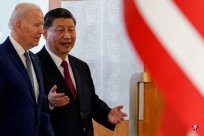Source: Guangming Daily
Author: Li Yulan, Wang Yang, Hu Xiaojun
In order to reduce plastic pollution, the world is looking for alternatives.In 2022, the China United International Bamboo and Team Organization jointly released the "Bamboo Plastic" initiative, which has attracted widespread attention.Recently, as the 12th China Bamboo Culture Festival was held in Zixi County, Fuzhou City, Jiangxi Province, this topic has caused in -depth discussion. How far is we from "Bamboo Plastic"?
excellent materials replaced by plastic
"Bamboo keyboard, bamboo mouse, from home supplies to car interior, electronic product shells, sports equipment, and then to the industrial field, such as cooling tower bamboo grid fillers, bamboo entanglement pipe galleries, etc., bamboo in at least 80%of the fieldsBoth can replace plastic.
Zixi, which is located on the west foot of the Wuyi Mountains, is one of the key production areas in China. The roads, lakeside, and front houses, the bamboo grows upright, the wind is passing, and there is sound.
Bamboo has been engineering materials since ancient times.More than 2000 years ago, Dujiangyan used the "stone cage" (with bamboo to install the cage with a cage) to consolidate the dam to prevent the river bank from being washed away.Bamboo crickets used in the Eastern Han Dynasty as a pipeline and irrigated farmland.Since the 1950s, it has been applied to many projects such as construction and transportation.
"Bamboo has three major environmental protection highlights: one is renewable and fast growth; the other is degradable, pollution -free, and non -waste; the third is that the carbon solidification ability is better than ordinary wood.1.33 times the tropical rain forest. "Li Hongming said that scientific and reasonable logging will not only damage the growth of bamboo forests, but also adjust the structure of bamboo forests and improve the quality of bamboo forests.
"Bamboo Plan" full of Chinese wisdom
According to reports, seven of the 17 sustainable development goals of the United Nations are related to bamboo, including the elimination of poverty, cheap and clean energy, responsible consumption and production, climate actions, land creatures, etc.
There are 1,642 species of bamboo plants in the world, and there are 837 species in China.The area of bamboo forests in the country is 7.53 million hectares, and it has increased year by year.Yu Wenji, chief scientist of the Chinese Academy of Forestry and Dean of the National Bamboo Industry Research Institute.
According to statistics, there are tens of thousands of Chinese bamboo products, covering all aspects of clothing, food, housing and transportation.In 2022, the industrial scale reached 415.3 billion yuan (RMB, the same below, about S $ 77.5 billion), the world's leading.China has obtained the number of patents and the number of papers in the field of bamboo, accounting for more than 80%of the world's.Taking Jiangxi as an example, there are 17.65 million mu of bamboo forest in the province and more than 1,400 bamboo processing enterprises.
"Jiangxi's bamboo eating bamboo and bamboo with bamboo has more than 4,000 years. There are a number of intangible cultural heritage such as Zixi Bamboo Painting, Ruichang Bamboo Corps, Lianlian Four Paper, Zhang Gong Hakka Bamboo Carving, Wuyuan Jialu Umbrella.At present, we are doing our best to do a good job in bamboo building materials, the foodization of bamboo shoots, the standardization of bamboo products, the industrialization of bamboo cultural industrialization, and the marketization of bamboo plastic.Chen Xiaoping, a member of the party group of the Jiangxi Provincial Government.
Fujian, Sichuan, Anhui, Zhejiang, Yunnan, Guangdong and other places with rich bamboo resources have introduced action plans to promote the "use of bamboo" operations.A group of bamboo material scientific research projects are being launched, and the National Bamboo Industry Research Institute is also established in Anji, Zhejiang.
Seize "Bamboo Opportunities"
However, as we perceive in our lives, although bamboo products are loved by many people, it seems far from "plastic".Where does the bamboo production industry contribute to the national economy, where is the entry point?
Wang Ge, a researcher at the International Bamboo and Team Center, said that the utilization rate of Chinese bamboo is less than 30%, and most of the material rate of Maogu is 30%to 50%.There are only 20 types of bamboo species, accounting for only 2.5%of all bamboo species, and about 50%of low -yield and low -quality bamboo forests.
"The outstanding problems in the bamboo industry include: high harvest costs, reflected in the cultivation model, harvesting method and machinery of bamboo forests; poor scale benefits, which are reflected in the low level of industrial bamboo products;Weak is a high value -added product reflected in the characteristics of bamboo materials. "Wang Ge said.
Yu Wenji said that China's bamboo industry is in international leading position in terms of scale and level, forming a relatively complete industrial system.However, China lacks leading companies with global competitiveness and masterpiece.There are more than 100 large enterprises with an annual output value of over 100 million yuan, and the largest enterprise output value is about 1 billion yuan. Most of them belong to small and micro enterprises and lack large brands.
"Replacement of bamboo" brings huge opportunities for the bamboo industry.In fact, bamboo can not only be plastic on behalf of the steel, but also have room for development of steel and wood to develop with bamboo production.How to "behave" became the core of seizing this wave of opportunities.
"Bamboo and plastic are high -molecular materials, which are based on bamboo plastic. The key is material replacement. We must think about which areas can be replaced around national strategic needs." Wang Ge said.
"Scientific research institutions, universities, and enterprises should form a joint effort to solve key technical problems, develop key equipment in the research and development industry, and achieve advanced manufacturing models. Establish a modern industrial system of the bamboo industry, classify the performance of different bamboo species, and achieve classification and study of different bamboo species to achieve large bamboo materials."Utilization and Julin Development" said "Yu Wenji said.


